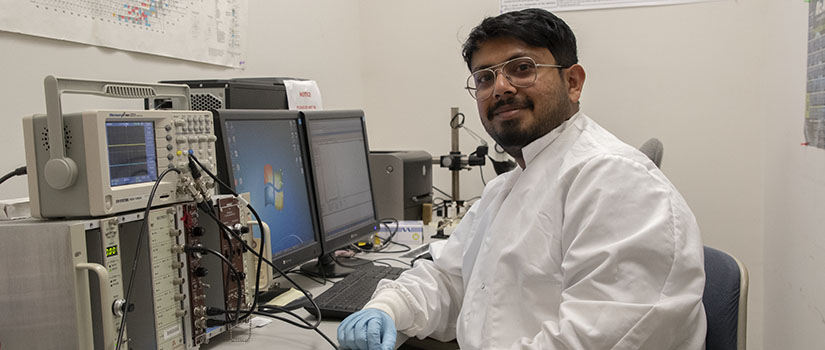Room Temperature Semiconductor Detectors are considered an important class of X-ray and gamma-ray sensors that perform high-resolution spectroscopy. Electrical Engineering doctoral candidate Ritwik Nag is currently pursuing research in this area and was recognized last semester for his work toward improving detection and resolution.
At the Institute of Electrical and Electronics Engineers Nuclear Science Symposium, Medical Imaging Conference, and Room Temperature Semiconductor Conference in Tampa, Florida last fall, Nag received the Room Temperature Semiconductor Detector Student Award for Best Poster. The title of his poster was, “Radiation Detection with Vertical Gradient Freeze Grown Cadmium Zinc Telluride Selenide Crystals.”
“It was a large conference with students from schools in the U.S., England, Italy and other countries. I was not expecting to win considering the competition, but I’m grateful,” Nag says. “I was deeply honored to meet esteemed researchers whose work I have long cited, as well as new colleagues from around the world working on groundbreaking advancements in imaging and detection.”
Nag’s current research is an extension of his work that began while earning his master’s degree in electrical engineering from the University of South Carolina. His work initially focused on cadmium zinc telluride (CZT), a semiconductor that operates at room temperature and is widely used in medical imaging and airport security. While CZT was an improvement from scintillators, which emit light when a material interacts with radiation, only 30% of the semiconductor was usable. This led Nag to an emerging semiconductor material, cadmium zinc telluride selenide, which has properties that mitigate issues in CZT.
Over a three-month period during his master’s studies, Nag grew a semiconductor crystal by utilizing a hot furnace and the Brigman method. In this technique, liquid material passes through a negative temperature gradient and causes solidification. Once grown, a device was fabricated from the crystal, which was used for radiation detection with americium (a soft radioactive metal) and gamma rays.
“After building the crystal, I had an idea to make 90% of it usable for a detector. While it normally takes three months, I wanted to optimize the time and do it as fast as possible,” Nag says.
Nag’s poster that he presented at the conference was on a new method of growing crystals, known as vertical gradient freeze. The process grows single crystals in bulk quantities to produce bulk compound semiconductor crystals. The process yields large crystals with low density and ideal uniformity.
“With vertical gradient freeze, we can grow a proper crystal in seven-to-10 days, which gives us better performance than the Bridgman method. Three months in a furnace might cause impurities or other issues. With a faster process, there’s a lesser chance of having impurities from the air,” Nag says.
Based on this work, Nag received funding last February through USC’s Support to Promote Advancement of Research and Creativity (SPARC) grant.
“About 90% of the detector that we now have can be used and has high resolution and works in a shorter period,” Nag says. “With the SPARC grant, we proposed to create a device with multiple detectors and signals for brain cancer imaging. We are working with a hospital in New York to build the detectors and connect the readout electronics with detectors in a helmet.”
Nag’s interest in semiconductors and electronics began at an early age, and he eventually focused on related semiconductor chips. While still an undergraduate, he attended a conference in India on the physics of semiconductor devices. This was also where he first met Electrical Engineering Professor Krishna Mandal.
“We talked and realized that we had a common interest in semiconductor devices. He asked me if I wanted to pursue a master's degree under him, and that's how I ended up in South Carolina,” Nag says.
Nag credits Mandal for being a supportive and enthusiastic mentor.
“The bulk of my ideas came from his courses. He encourages me and all his students to publish their findings because this validates the work,” Nag says. “He also goes into the depth really well, which helps me understand all aspects of semiconductors.”
Mandal describes Nag as an exemplary Ph.D. student, distinguished by his innovative approach, creativity, and commitment to excellence in both research and academics.
“His work in the laboratory reflects a passion for exploration and a drive to push the boundaries of knowledge. Not only are his contributions academically significant, but they also have the potential to address real-world challenges,” Mandal says. “Ritwik is recognized for his meticulous attention to detail and his ability to balance research demands with the practical needs of the lab and research projects.”
Nag will complete his doctoral studies in 2026 and like Mandal, plans to remain in academia.
“I want to pass on what I’ve learned to a newer generation of students and help them continue my research,” Nag says. “I feel that the research I'm doing is for the betterment of all people.”
